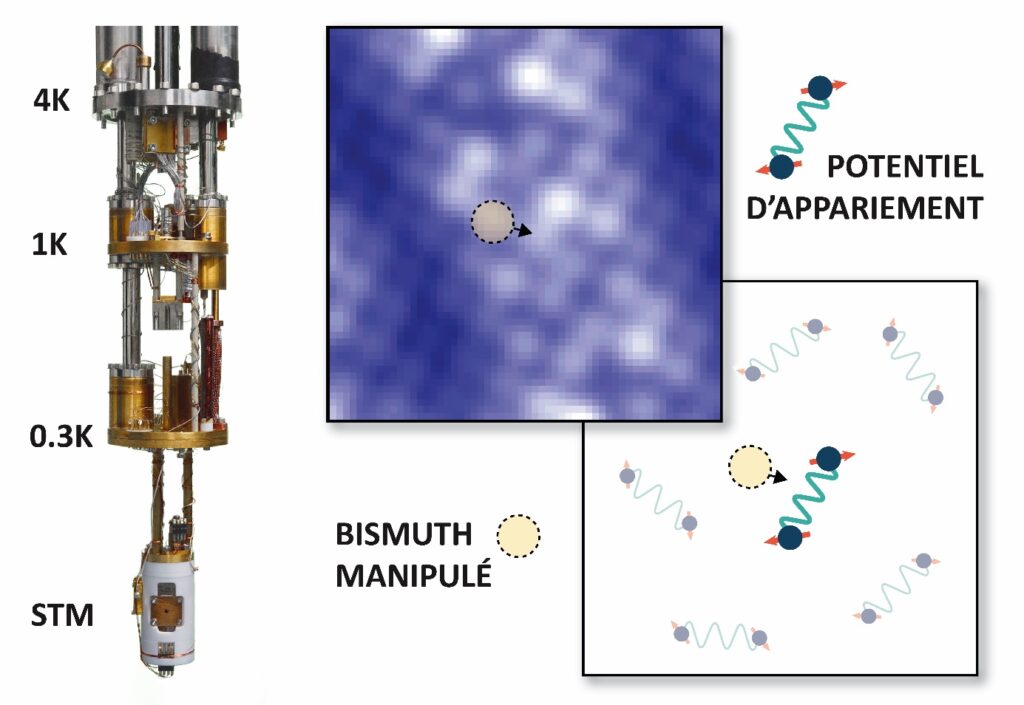Many interesting properties in condensed matter systems originate from interactions between electrons. Since these interactions usually take place on short time scales, a measurement of time-averaged properties is often missing crucial information. In order to gain access to interactions and electron dynamics, Freek Massee, together with members of the NS2 group at the LPS in collaboration with researchers at C2N, has developed and built a new scanning tunnelling microscope (STM) with circuitry that enables measurements of current fluctuations with atomic scale spatial precision1 Atomic scale shot-noise using cryogenic MHz circuitry
F. Massee, Q. Dong, A. Cavanna, Y. Jin and M. Aprili
Review of Scientific Instruments 89, 093708 (2018)
https://doi.org/10.1063/1.5043261 [1].
Using this novel instrument, they studied the high temperature superconductor Bi2Sr2CaCu2O8+x. In this material, superconductivity is achieved through adding oxygen atoms, or dopants, to the system. They discovered that the tunnelling current-noise is enhanced by at least an order of magnitude at a select number of such oxygen dopants2 Noisy defects in the high-Tc superconductor Bi2Sr2CaCu2O8+x
F. Massee, Y. K. Huang, M. S. Golden and M. Aprili
Nature Communications 10, 544 (2019)
https://doi.org/10.1038/s41467-019-08518-1 [2] . This strong enhancement of the noise is indicative of unconventional charge dynamics arising from ionization of the dopants, which is usually only observed in semiconductor systems. The ionization of these dopants opens up new routes to control doping at the atomic scale as function of time, enabling the direct visualization of local charging on e.g. high temperature superconductivity.

Furthermore, by taking advantage of the electric field between the tip and sample in the scanning tunnelling microscope, Massee and co-workers have discovered that it is possible to selectively move individual oxygen dopants and surface bismuth atoms. Since these single atom manipulations are non-invasive and reversible, they enable detailed studies of the electronic properties to be performed before and after manipulation. This technique therefore effectively removes the inhomogeneous environment and gives direct insight into the effect of single atoms on the electronic properties. Although manipulating the noisy oxygen dopants is shown to have little effect, they find that by moving bismuth atoms at the surface of Bi2Sr2CaCu2O8+x, the spectral gap that is associated with the local strength of superconductivity can be directly manipulated 3Atomic manipulation of the gap in Bi2Sr2CaCu2O8+x
F. Massee, Y. K. Huang and M. Aprili
Science 367, 68-71 (2020)
https://doi.org/10.1126/science.aaw7964 [3]. This suggests that the single atoms locally enhance pairing, providing new insight into the pairing mechanism of these systems.
References
[1] Atomic scale shot-noise using cryogenic MHz circuitry
F. Massee, Q. Dong, A. Cavanna, Y. Jin and M. Aprili
Review of Scientific Instruments 89, 093708 (2018)
https://doi.org/10.1063/1.5043261
[2] Noisy defects in the high-Tc superconductor Bi2Sr2CaCu2O8+x
F. Massee, Y. K. Huang, M. S. Golden and M. Aprili
Nature Communications 10, 544 (2019)
https://doi.org/10.1038/s41467-019-08518-1
[3] Atomic manipulation of the gap in Bi2Sr2CaCu2O8+x
F. Massee, Y. K. Huang and M. Aprili
Science 367, 68-71 (2020)
https://doi.org/10.1126/science.aaw7964
Contact
Freek Massee

Freek Massee is laureate of the bronze medal from CNRSLaurent Ardhuin for the CNRS
